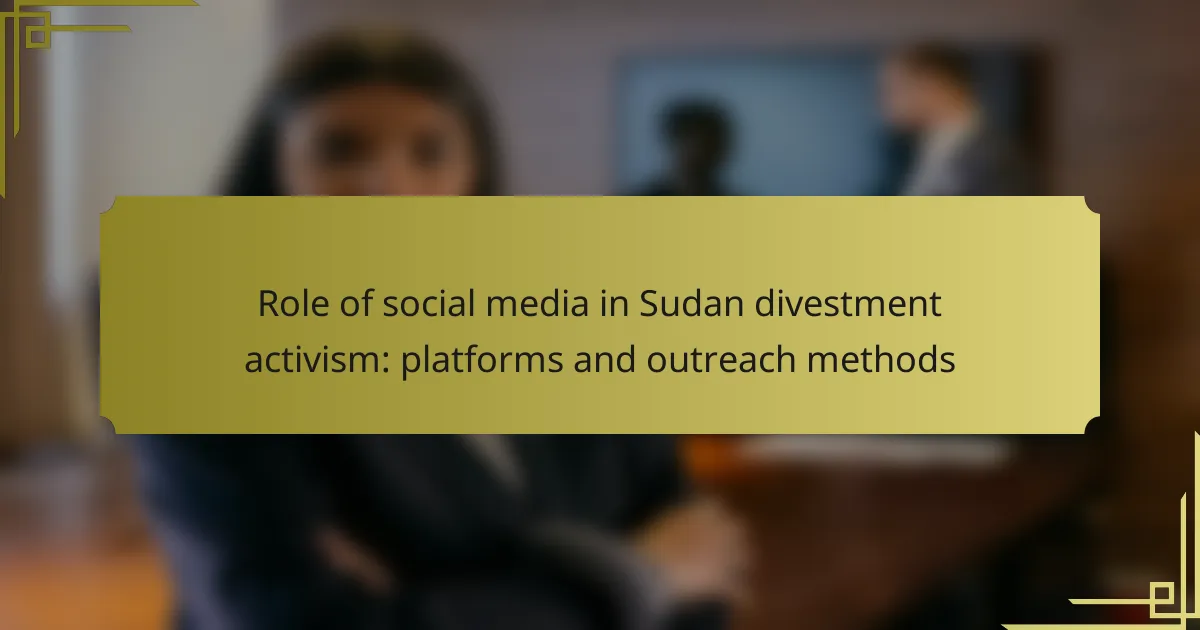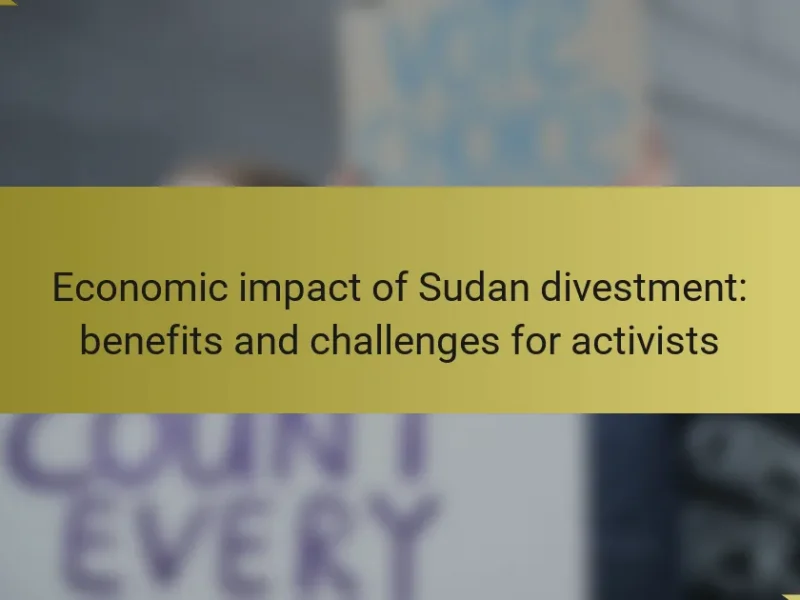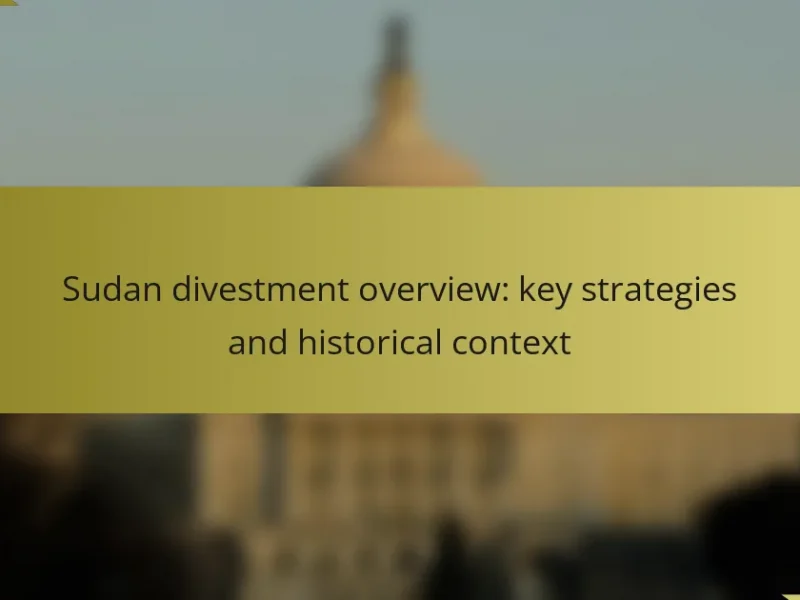Social media is a pivotal tool in Sudan divestment activism, enabling awareness, mobilization, and community building among activists. Platforms such as Twitter, Facebook, Instagram, and TikTok facilitate the dissemination of information regarding human rights violations in Sudan, driving global pressure for corporate divestment. Effective campaigns utilize strategic messaging, visual content, and real-time engagement to enhance participation and support. Additionally, social media analytics provide insights that guide future activism efforts, ensuring sustained engagement and community involvement. Overall, the role of social media in this context underscores its importance as a catalyst for grassroots activism and corporate accountability.
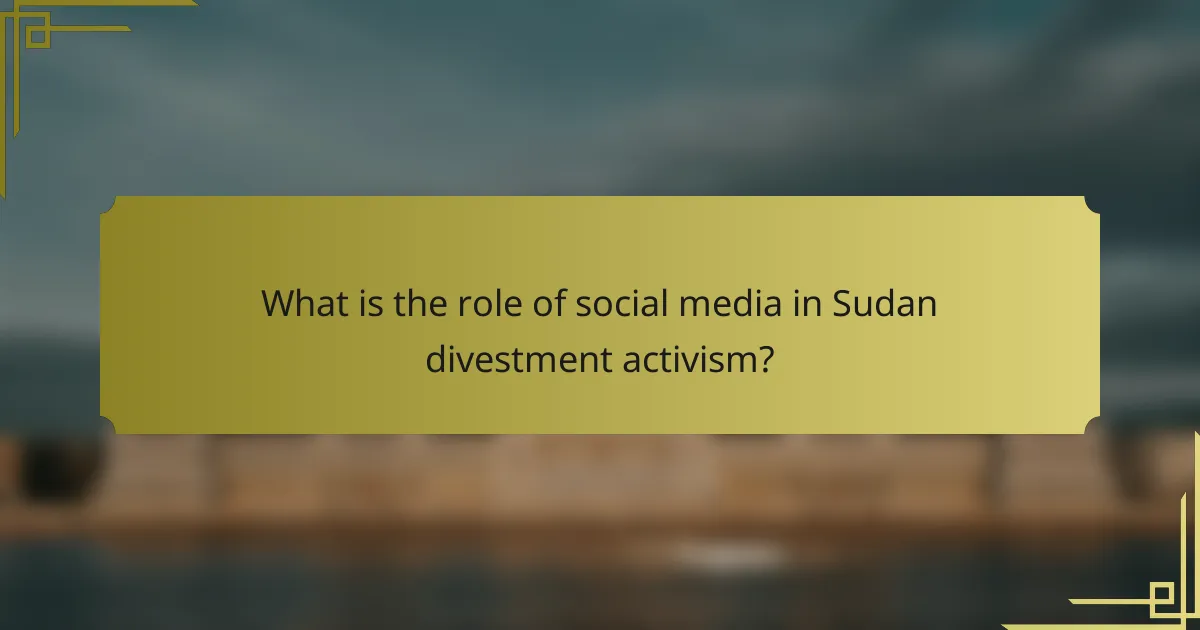
What is the role of social media in Sudan divestment activism?
Social media plays a crucial role in Sudan divestment activism by facilitating awareness and mobilization. Activists use platforms like Twitter and Facebook to share information about the human rights violations in Sudan. This information reaches a global audience, increasing pressure on companies to divest. Social media also enables the organization of campaigns and events, making grassroots activism more effective. For example, hashtags like #DivestSudan have rallied support and created a sense of community among activists. Additionally, social media allows for real-time updates and engagement, keeping the issue in public discourse. Studies show that social media campaigns can significantly impact public opinion and corporate decisions.
How has social media influenced activism in Sudan?
Social media has significantly influenced activism in Sudan by facilitating communication and mobilization among activists. It has allowed for real-time sharing of information during protests and events. Platforms like Twitter and Facebook have been crucial for organizing demonstrations. They enable activists to reach a wider audience quickly. Social media also provides a space for sharing personal stories and experiences. This fosters solidarity and encourages participation. Additionally, it has helped to document human rights abuses. The visibility gained through social media amplifies calls for justice and accountability. Overall, social media has transformed the landscape of activism in Sudan by enhancing outreach and engagement.
What specific platforms are most commonly used for this activism?
Twitter, Facebook, and Instagram are the most commonly used platforms for Sudan divestment activism. These platforms facilitate widespread information sharing and community engagement. Twitter allows activists to share updates and mobilize support quickly. Facebook groups enable discussions and organization of events. Instagram is effective for visual storytelling and raising awareness through impactful imagery. Reports indicate that these platforms have significantly increased visibility for divestment efforts. Many organizations leverage them to reach diverse audiences and enhance their outreach strategies.
How do these platforms facilitate communication among activists?
Social media platforms facilitate communication among activists by providing instant connectivity and information sharing. They enable real-time updates about events, campaigns, and actions. Activists can create dedicated groups or pages to foster discussions and organize efforts. These platforms also allow for the dissemination of multimedia content, enhancing engagement. Hashtags help categorize information and increase visibility. Additionally, platforms support direct messaging, facilitating private conversations among activists. According to a 2020 study by the Pew Research Center, 69% of adults in the U.S. use social media to connect with others who share their interests. This demonstrates the effectiveness of social media in mobilizing and uniting activist communities.
What are the key outreach methods employed on social media?
Key outreach methods employed on social media include content sharing, targeted advertising, and community engagement. Content sharing involves posting informative and persuasive materials, such as articles and videos, to raise awareness. Targeted advertising allows organizations to reach specific demographics effectively. Community engagement fosters interaction through comments, polls, and live sessions. These methods enhance visibility and mobilize support for causes like Sudan divestment activism. Research shows that social media campaigns can significantly increase participation and influence public opinion on social issues.
How do activists use hashtags to promote divestment?
Activists use hashtags to promote divestment by creating a unified message. Hashtags increase visibility and engagement on social media platforms. They help organize campaigns by linking related posts. Activists often use specific hashtags like #DivestSudan to raise awareness. This strategy connects individuals and groups advocating for divestment. Hashtags also facilitate the tracking of conversations and trends. Research shows that posts with hashtags can reach a broader audience. This method enhances the effectiveness of activism by mobilizing support quickly.
What role do visual content and storytelling play in outreach?
Visual content and storytelling are crucial in outreach efforts. They engage audiences more effectively than text alone. Visuals can convey complex messages quickly and clearly. Storytelling creates emotional connections with the audience. According to research, people remember 80% of what they see and do, compared to only 20% of what they read. This enhances message retention and encourages sharing. In the context of Sudan divestment activism, compelling visuals can highlight the urgency of the cause. Storytelling can personalize the impact of divestment, making it relatable. Together, they drive higher engagement and mobilize support for social change.
What challenges do activists face when using social media?
Activists face several challenges when using social media. Misinformation can spread rapidly, undermining their messages. Privacy concerns arise as activists risk exposure and potential backlash. Algorithms may limit the visibility of their posts, reducing engagement. Online harassment can deter participation and silence voices. Moreover, digital surveillance by authorities poses a significant threat. Activists also struggle with maintaining authenticity amid curated online personas. Lastly, the fast-paced nature of social media can lead to burnout and fatigue among activists. These challenges complicate their efforts in raising awareness and mobilizing support.
How do censorship and government surveillance impact activism?
Censorship and government surveillance significantly hinder activism. They restrict the flow of information and limit free expression. Activists often face harassment and intimidation, discouraging participation. Surveillance creates a climate of fear, leading to self-censorship among potential supporters. In Sudan, government monitoring of social media has stifled dissent. Reports indicate that activists have been arrested for online expressions. Censorship laws can block access to critical platforms. This limits outreach and reduces the effectiveness of mobilization efforts. Consequently, activism becomes less visible, weakening its impact.
What are the risks associated with online activism in Sudan?
Online activism in Sudan carries significant risks. Activists may face government surveillance and repression. The Sudanese government has a history of monitoring online activities. This can lead to arrests and harassment of individuals expressing dissent. Cybersecurity threats also pose risks, including hacking and data breaches. Activists’ personal information may be exposed, endangering their safety. Additionally, misinformation can undermine the credibility of online movements. The digital divide in Sudan limits access to technology for many, affecting outreach efforts. These factors create a challenging environment for effective online activism.
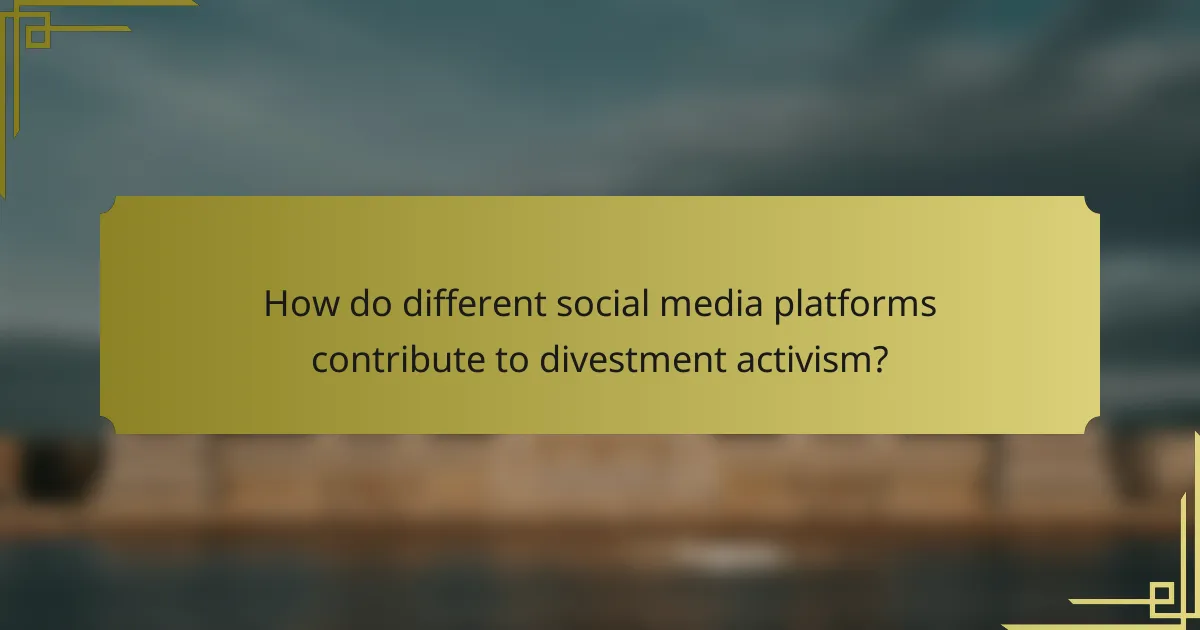
How do different social media platforms contribute to divestment activism?
Different social media platforms contribute to divestment activism by facilitating communication and mobilization among activists. Twitter allows for real-time updates and hashtags, increasing visibility for divestment campaigns. Facebook enables community building through groups and event organization, fostering collective action. Instagram provides a visual platform to share impactful imagery and stories that resonate emotionally with audiences. TikTok engages younger demographics through short, creative videos that can go viral, spreading awareness rapidly. Social media analytics can track engagement and measure the impact of campaigns, guiding strategies for future actions. Research shows that campaigns leveraging social media have seen increased participation and support, demonstrating its effectiveness in activism.
What unique features do platforms like Twitter and Facebook offer?
Twitter offers real-time updates and a character limit that encourages concise communication. This platform is designed for quick sharing of information, making it effective for urgent news dissemination. Hashtags on Twitter facilitate trending topics and community engagement.
Facebook provides a more extensive platform for content sharing, allowing for longer posts and multimedia integration. It supports community building through groups and events. Facebook’s algorithms prioritize content based on user interactions, enhancing visibility for posts that resonate with audiences.
Both platforms enable user-generated content, fostering grassroots activism. They also offer tools for targeted advertising, helping activists reach specific demographics. These unique features contribute to their effectiveness in mobilizing support for causes like Sudan divestment activism.
How does the audience demographic differ across these platforms?
The audience demographic differs significantly across social media platforms. For instance, Facebook users tend to be older, with a majority aged 25 to 54. In contrast, Instagram attracts a younger demographic, primarily users aged 18 to 29. Twitter users often fall within the 18 to 29 age range as well, but also have a notable presence of users aged 30 to 49. LinkedIn, on the other hand, is predominantly used by professionals aged 30 and above, focusing on career-oriented content.
These differences affect how Sudan divestment activism is communicated. Older audiences on Facebook may prefer detailed articles and community engagement. Younger users on Instagram and Twitter often favor visual content and quick updates. LinkedIn users may engage with professional insights and networking opportunities related to divestment efforts.
Research shows that platform choice influences user engagement and activism effectiveness. Understanding these demographic nuances is crucial for tailoring outreach strategies in Sudan divestment activism.
What engagement strategies are most effective on each platform?
Facebook engagement strategies include creating event pages and utilizing targeted ads. These features help mobilize support and increase visibility. Instagram strategies focus on visually compelling content and stories. High-quality images and short videos can effectively capture attention. Twitter engagement relies on concise messaging and trending hashtags. This approach fosters quick information dissemination and facilitates discussions. LinkedIn is best for professional networking and sharing in-depth articles. This platform allows for connecting with industry leaders and potential allies. Each platform’s unique features should be leveraged to maximize engagement.
How do platforms support community building among activists?
Platforms support community building among activists by providing spaces for communication and collaboration. They facilitate the sharing of information and resources among like-minded individuals. Social media platforms allow activists to create groups and forums for discussion. These features help to mobilize support for various causes. Additionally, platforms enable the organization of events and campaigns. They also provide tools for fundraising and awareness-raising initiatives. Research indicates that social media engagement can significantly enhance community solidarity. A study by the Pew Research Center found that 69% of adults use social media, fostering connections among activists.
What role do groups and pages play in fostering collaboration?
Groups and pages play a crucial role in fostering collaboration by providing a dedicated space for individuals to connect and share ideas. These platforms facilitate communication among like-minded individuals, enabling them to discuss strategies and coordinate actions. In the context of Sudan divestment activism, groups allow activists to mobilize support and disseminate information quickly. Pages serve as a central hub for updates, events, and resources related to the cause. This collective engagement enhances visibility and encourages participation. Research indicates that online communities significantly boost collaborative efforts by increasing access to diverse perspectives and expertise.
How do events and live streams enhance community engagement?
Events and live streams enhance community engagement by creating interactive platforms for participation. They allow real-time communication between organizers and participants. This interaction fosters a sense of belonging among community members. According to a study by the Pew Research Center, 54% of social media users engage more with organizations during live events. Additionally, events provide opportunities for networking and collaboration. Live streams can reach wider audiences, increasing awareness and participation. This accessibility encourages diverse voices to be heard. Overall, these tools strengthen community ties and promote active involvement.
What impact do social media campaigns have on public awareness?
Social media campaigns significantly enhance public awareness. They facilitate rapid dissemination of information to a wide audience. Campaigns can increase engagement through likes, shares, and comments. This interaction fosters a sense of community and collective action. Research shows that social media can amplify messages by up to 10 times compared to traditional media. For instance, the hashtag #SudanDivestment gained traction, raising awareness about divestment issues. Social media also allows for targeted outreach, reaching specific demographics effectively. Overall, social media campaigns play a crucial role in shaping public perception and mobilizing action.
How do campaigns translate online support into real-world actions?
Campaigns translate online support into real-world actions by mobilizing communities and leveraging digital platforms. They utilize social media to raise awareness and gather support for specific causes. For instance, campaigns often encourage followers to participate in petitions, protests, or donations. This engagement transforms online interactions into tangible efforts. Research shows that social media can increase participation rates in activism by up to 50%. Additionally, campaigns often provide clear calls to action that direct online supporters to offline events. This strategy effectively bridges the gap between virtual support and physical involvement.
What metrics are used to measure the success of these campaigns?
Metrics used to measure the success of campaigns include engagement rates, reach, and conversion rates. Engagement rates track interactions such as likes, shares, and comments. Reach measures the total number of unique users who see the campaign content. Conversion rates indicate the percentage of users who take a desired action, such as signing a petition or making a donation. Additionally, sentiment analysis gauges public opinion and reactions to the campaign. Tracking these metrics helps assess the overall effectiveness and impact of social media efforts in Sudan divestment activism.
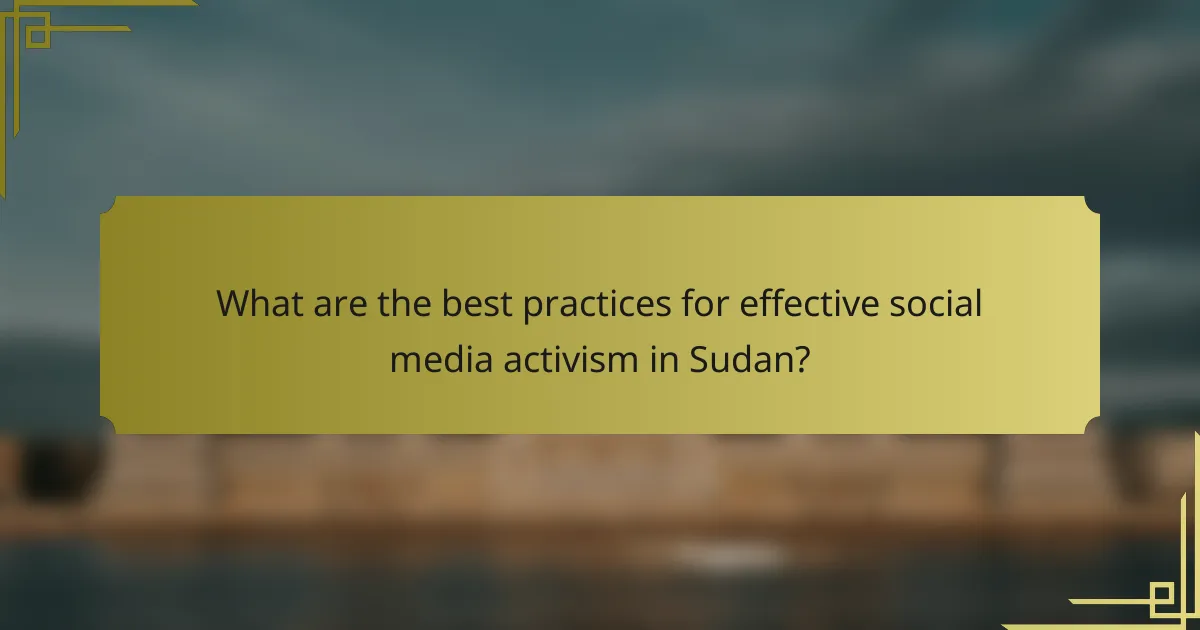
What are the best practices for effective social media activism in Sudan?
Effective social media activism in Sudan requires strategic planning and community engagement. Activists should utilize platforms like Twitter, Facebook, and Instagram for broader outreach. Clear messaging is essential; concise, impactful posts resonate more with audiences. Visual content, such as infographics and videos, enhances engagement and shares crucial information effectively. Collaborating with local influencers can amplify the message and reach diverse demographics. Consistent updates keep the community informed and engaged in ongoing initiatives. Monitoring trends and adapting strategies based on audience feedback is vital for sustained activism. Documenting and sharing success stories can inspire further participation and support.
How can activists maximize their outreach on social media?
Activists can maximize their outreach on social media by creating engaging content and utilizing targeted campaigns. They should focus on storytelling to connect with audiences emotionally. Consistent posting increases visibility and engagement rates. Using relevant hashtags helps reach broader audiences. Collaborating with influencers amplifies messages effectively. Engaging with followers through comments fosters community. Analyzing metrics helps refine strategies for better results. Research indicates that visual content generates 94% more views, enhancing outreach potential.
What strategies can be employed to create compelling content?
To create compelling content, employ strategies such as understanding your audience, using storytelling, and optimizing for SEO. Understanding the audience ensures content resonates with their interests and needs. Storytelling engages readers emotionally, making the content memorable. Optimizing for SEO increases visibility, ensuring the content reaches a wider audience. Incorporating visuals enhances engagement, as studies show that articles with images receive 94% more views. Additionally, using clear calls-to-action guides readers on the next steps. Regularly updating content keeps it relevant and encourages repeat visits. Lastly, analyzing performance metrics helps refine future content strategies.
How can activists build a strong online network for support?
Activists can build a strong online network for support by utilizing social media platforms effectively. They should identify and engage with target audiences on platforms like Twitter, Facebook, and Instagram. Regularly sharing informative content increases visibility and attracts followers. Collaborating with influencers can amplify their message and reach broader audiences. Creating dedicated online groups fosters community and encourages active participation. Utilizing hashtags related to their cause enhances discoverability and connects them with like-minded individuals. Hosting virtual events or webinars can facilitate direct interaction and deepen connections. Evidence shows that social media campaigns can mobilize large groups quickly, as seen in various successful activism movements.
What are common pitfalls to avoid in social media activism?
Common pitfalls to avoid in social media activism include spreading misinformation. This can undermine credibility and cause confusion. Another pitfall is engaging in performative activism. This often leads to superficial support without real impact. Failing to engage with affected communities is also problematic. Activism should prioritize the voices and needs of those directly impacted. Additionally, over-reliance on social media can limit outreach. Effective activism often requires offline efforts and coalition-building. Lastly, neglecting to follow up on campaigns can diminish their effectiveness. Continuous engagement is crucial for sustaining momentum and achieving long-term goals.
How can misinformation be countered effectively?
Misinformation can be countered effectively through fact-checking and transparency. Fact-checking organizations verify claims and provide accurate information. Social media platforms can implement policies to flag or remove false content. Educating users about recognizing credible sources is essential. Encouraging critical thinking helps individuals assess information reliability. Collaborative efforts with trusted organizations enhance outreach and credibility. Data shows that fact-checking reduces the spread of false information by 70%. Engaging communities in discussions fosters a culture of skepticism towards unverified claims.
What practices ensure the safety of activists online?
Activists can ensure their safety online by employing several key practices. Utilizing strong, unique passwords is essential. Activists should enable two-factor authentication for added security. They must be cautious about sharing personal information on social media. Using encrypted messaging apps enhances privacy during communication. Regularly updating software and applications protects against vulnerabilities. Activists should also be aware of phishing attempts and avoid suspicious links. Utilizing VPNs can help mask their IP addresses. Lastly, staying informed about digital security trends is vital for ongoing protection. These practices collectively create a safer online environment for activists.
What resources are available for activists to improve their social media skills?
Activists can improve their social media skills through various resources. Online courses from platforms like Coursera and Udemy offer structured learning. These courses cover topics such as content creation, audience engagement, and analytics. Additionally, organizations like Hootsuite provide free webinars and tutorials. These resources equip activists with practical skills for effective social media use. Nonprofits like the Nonprofit Technology Network (NTEN) also offer workshops tailored for activists. These workshops focus on leveraging social media for advocacy. Furthermore, books like “Social Media for Social Good” provide in-depth strategies. These resources collectively enhance activists’ social media capabilities.
Where can activists find training and support for digital activism?
Activists can find training and support for digital activism through various organizations and platforms. Notable resources include the Digital Activism Research Project, which provides educational materials and workshops. The Tactical Technology Collective offers tools and guides for effective digital campaigning. Additionally, organizations like Amnesty International and Human Rights Watch often conduct training sessions focusing on digital strategies for advocacy. Online platforms such as Coursera and edX feature courses on digital activism and social media strategies. These resources equip activists with essential skills and knowledge for effective engagement in digital spaces.
What tools can help manage and analyze social media efforts?
Social media management tools can effectively help manage and analyze social media efforts. Popular tools include Hootsuite, Buffer, and Sprout Social. Hootsuite allows scheduling posts across multiple platforms and provides analytics on engagement. Buffer offers similar scheduling features and detailed performance metrics. Sprout Social focuses on social listening and engagement tracking. These tools enable users to monitor audience interactions and measure campaign effectiveness. According to a 2021 report by HubSpot, 73% of marketers use social media management tools to enhance their strategies. This demonstrates the importance of utilizing such tools for successful social media efforts.
The main entity of the article is social media’s role in Sudan divestment activism. The article explores how platforms like Twitter, Facebook, and Instagram facilitate awareness, mobilization, and community engagement among activists. It outlines the key outreach methods employed, including content sharing, targeted advertising, and the use of hashtags to promote divestment. Additionally, the article discusses the challenges activists face, such as misinformation and government surveillance, while highlighting best practices for effective online activism. Overall, it emphasizes the significant impact of social media campaigns on public awareness and real-world actions related to divestment efforts in Sudan.
